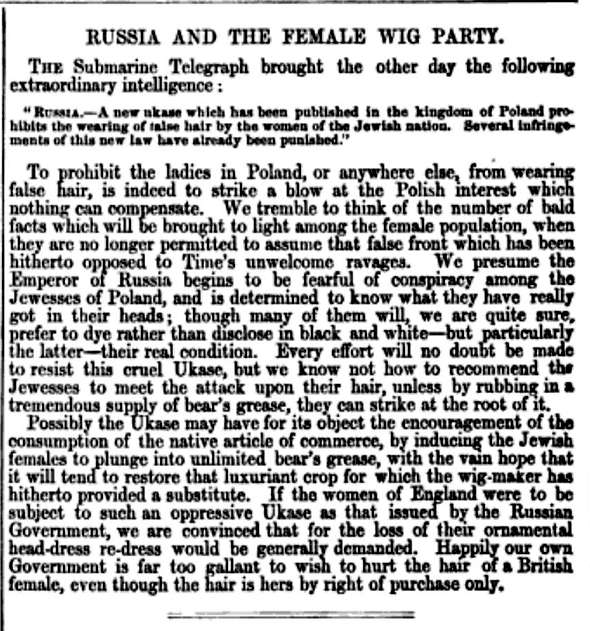In 1852 the Russian Czar, as part of a continuing policy of Russification and harassment of his subject Jews, issued an order fining Jewish women who shaved their head 5 rubles. This came on the heels of the ban itself (1851) and a more general ban on Jewish dress (1850), which included a prohibition of growing peyos. Raphael Mahler claimed that the custom of tucking peyos behind the ear dates to this period, and he may well be right. Certainly earlier depictions of Russian Jews never show such peyos. So if he was right, that's how old this tradition is. But I digress. With the ban on shaving the head came, naturally, many police inspections, and not only the women were implicated, but also the rabbis and barbers (according to Dubnow).
In 1853 the British satirical magazine
Punch ran the following about Jewish woman's
sheitlach:

I think that the reason why
Punch took it as a ban on wigs is because it reasoned that the women wore wigs because they shaved their head. If they didn't shave their head, they wouldn't wear wigs. Thus in effect wigs were banned, and a great pun was there for the picking. If only they knew (about the wigs, that is).






You have an interesting hypothesis about peyot tucking. The way to test it would be to scrutinize comparable photos in Austro-Hungarian lands.
ReplyDeleteIt's not my hypothesis, it's Raphael Mahler's. He mentioned it on his book about the conflict between Chassidim and Maskilim. The way he mentions it one gets the sense that he is reporting something he knew (or thought he knew) rather than something he was hypothesizing himself.
ReplyDeleteIn any case, is it not incorrect that only so-called Litvaks and Poilish Chassidim put their peyos behind their ear, or up (albeit in different ways)? I don't know for sure, but on the face of it that seems right.
In case anyone was thinking, what about the beard, the Czar didn't ban beards as they were considered properly Russian.
Hi S.,
ReplyDeleteI apologize that this is unrelated to the thread (and you may delete it after you have answered), but do you know of any online PDF of Ben-Yehuda's Dictionary?
I came up with the same theory about peyos. I would add that Chabad developed a religious justification for not growing peyos as a result of the decree.
ReplyDeleteEastern European Jews who lived in lands not under control of the Czar did, in fact, wear peyos on the side.
Another point: Yeshaya Trunk, in his masterpiece on Jewish Polish "Poyln", refers to a certain person as sporting "Kireshe Peyos" -- Galitzian peyos. My guess is that he means peyos on the side, althought it is also possible to conjecture that he was referring to peyos wrapped around the ear, as is the style in Belz.
It's possible that other Jews copied Russian Jews, especially once it became a style. My impression is that these laws were not enforced very much after the 1850s, so long as it was just a style and no longer perceived as something forced by the Czar, perhaps people felt comfortable copying it. Also, people from Russia may have brought it with them upon moving to non-Czarist territory (although I don't know much about if there even was such migration).
ReplyDeleteThe reason why I think this is intriguing is because Mahler was himself an Eastern European Jew of two generations ago, so his conjecture may be based on oral tradition more so than mine or your conjecture. Either way, it certainly does seem to be the case that in depictions of Russian/ Polish Jews before the 1850s or 60s you really don't see them with peyos behind the ear.